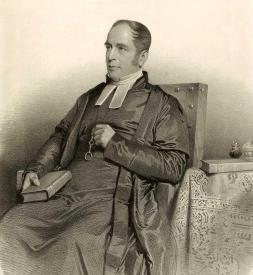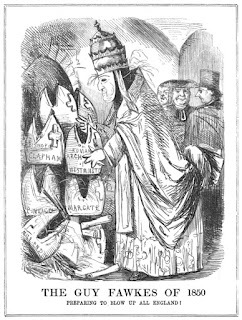Preview: The Restoration of the Hierarchy/the Gorham Judgment/Anglican Difficulties: 1850
 One hundred and seventy five years ago, three events in England now offer some context to the history of religion in England for us to consider:
One hundred and seventy five years ago, three events in England now offer some context to the history of religion in England for us to consider: 1. On September 29, 1850 Blessed Pope Pius IX restored the Catholic hierarchy in England, an act of "Papal Aggression" according to the Queen and her Parliament;
2. The Gorham Judgment on March 8, 1850 led several more Tractarians to "Cross the Tiber";
3. Oratorian Father John Henry Newman reached out to those Tractarians with his public Lectures on Difficulties Felt by Anglicans in Submitting to the Catholic Church, starting in July 1850.
So on Monday, September 29, the feast of the Archangels, we'll consider these 2025 Anniversaries in our Son Rise Morning Show series by focusing on the Gorham Judgment, which, like later decisions in the Church of England, led some on the edge of conversion to "submit" to the Catholic Church. I'll be on the air at my usual time around 7:50 a.m. Eastern/6:50 a.m. Central to discuss this anniversary and its importance. Please listen live here or catch the podcast later here.
The Reverend George Cornelius Gorham (1787-1857) was appointed to a "living" (a pastoral position) at the vicarage in Bramford Speke in Exeter. The Anglican bishop of that diocese--the appointment was made by the Lord Chancellor, Charles Christopher Pepys, 1st Earl of Cottenham--Henry Phillpotts, refused to install Gorham in the living because Gorham's views on Baptism weren't orthodox according to Church of England doctrine. He did not believe in the Sacramental Grace of Baptism to be salvific but as conditional. Gorham appealed to the Anglican Bishops Court of Arches and lost on appeal. So Gorham took his cause to the Judicial Committee of the Privy Council, a secular authority, who overruled the Bishops Court.
To those who'd remained in the Tractarian/Oxford Movement, this was a real blow. Henry Manning, the Archdeacon particularly felt the blow. Newman's "defection" and the bishops' action against the Movement had been bad enough, but here was more proof that the Church of England was an Erastian church, under the control of the secular state which presumed to determine what the Church believed. The Privy Council, not the Court of Arches, had interpreted the Thirty-Nine Articles--this was a real crisis.
 Manning and others, including William Gladstone, made an appeal to the bishops to undo this Privy Council action. When that was ignored, Manning and others--but not Gladstone--made the great decision to convert to Catholicism. Among those who joined Manning: Thomas William Allies, William Wilberforce, Jr. and his brothers Robert and Henry Wilberforce, sons of "The Great Emancipator", William Wilberforce, Sr.; John Hungerford Pollen, William Dodsworth, James Hope-Scott, and Edward Badeley.
Manning and others, including William Gladstone, made an appeal to the bishops to undo this Privy Council action. When that was ignored, Manning and others--but not Gladstone--made the great decision to convert to Catholicism. Among those who joined Manning: Thomas William Allies, William Wilberforce, Jr. and his brothers Robert and Henry Wilberforce, sons of "The Great Emancipator", William Wilberforce, Sr.; John Hungerford Pollen, William Dodsworth, James Hope-Scott, and Edward Badeley.The context of those conversions, taking place even as Queen Victoria and Parliament felt threatened by Pope Pius IX appointing Catholic bishops to organize Catholic dioceses in England, was momentous. Newman saw the opportunity to reach out to Manning and others, using arguments to answer the kind of difficulties he'd encountered along the way to his conversion, and therefore offered a lecture series in London on those Anglican Difficulties.
In the wake of the Gorham Judgment, he emphasized the Erastian nature of the Established Church. In the first lecture "On the Relation of the National Church to the Nation" he warned them:
He was warning them that the Erastian Church of England would follow the spirit of the age and the interests of the establishment and that "changes in the nation" would be the source of church teaching, not those "Truths divinely revealed, developed, and explained by men of genius in the past . . ."
I have said all this, my brethren, not in declamation, but to bring out clearly to you, why I cannot feel interest of any kind in the National Church, nor put any trust in it at all from its past history, as if it were, in however narrow a sense, a guardian of orthodoxy. It is as little bound by what it said or did formerly, as this morning's newspaper by its former numbers, except as it is bound by the Law; and while it is upheld by the Law, it will not be weakened by the subtraction of individuals, nor fortified by their continuance. Its life is an Act of Parliament. It will not be able to resist the Arian, Sabellian, or Unitarian heresies now, because Bull or Waterland resisted them a century or two before; nor on the other hand would it be unable to resist them, though its more orthodox theologians were presently to leave it. It will be able to resist them while the State gives the word; it would be unable, when the State forbids it. Elizabeth boasted that she "tuned her pulpits;" Charles forbade discussions on predestination; George on the Holy Trinity; Victoria allows differences on Holy Baptism. While the nation wishes an Establishment, it will remain, whatever individuals are for it or against it; and that which determines its existence will determine its voice. Of course {9} the presence or departure of individuals will be one out of various disturbing causes, which may delay or accelerate by a certain number of years a change in its teaching: but, after all, the change itself depends on events broader and deeper than these; it depends on changes in the nation. As the nation changes its political, so may it change its religious views; the causes which carried the Reform Bill and Free Trade may make short work with orthodoxy.
After 1850, there have been other decisions made in the Church of England that have incited Anglican pastors and laymen to become Catholic, like ordaining women as priests and bishops. Pope Saint John Paul II, with the Pastoral Provision, and Pope Benedict XVI, with the creation of the Anglican Ordinariate, acknowledged the impact of such decisions by welcoming Episcopalian and Anglican clergy to the Catholic priesthood, even if married after their conversions, if they felt the call.
Saint John Henry Newman, pray for us!Blessed Pius IX, pray for us!
Image Credit (Public Domain): Portrait of the Reverend George Cornelius Gorham



